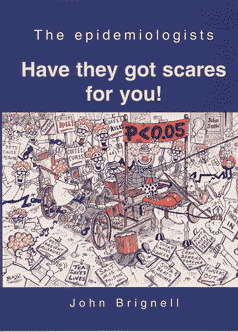



“John Brignell's books — Sorry, Wrong Number and The Epidemiologists — are at the top of my list in learning about statistical illiteracy.” — Milo Schield
Brignell's Website: Number Watch
“All about the scares, scams, junk, panics, and flummery cooked up by the media, politicians, bureaucrats, so-called scientists and others who try to confuse you with wrong numbers. Working to combat Math Hysteria.”
“This site is devoted to the monitoring of the misleading numbers that rain down on us via the media. Whether they are generated by Single Issue Fanatics (SIFs), politicians, bureaucrats, quasi-scientists (junk, pseudo- or just bad), such numbers swamp the media, generating unnecessary alarm and panic. They are seized upon by media, hungry for eye-catching stories. There is a growing band of people whose livelihoods depend on creating and maintaining panic. There are also some who are trying to keep numbers away from your notice and others who hope that you will not make comparisons. Their stock in trade is the gratuitous lie. The aim here is to nail just a few of them.”
Excerpt: From How We Know They Know They Are Lying
Patronage
There is a long and respectable history of patronage in science as well as art, literature, lexicography etc. The patrons (other than the church) used their own money. The modern patrons, however, are bureaucrats who use the money of others; to whit, taxpayers. Their science is not the science of recent tradition, but a whole new ball game.
There are major differences between real science and bureaucratic science (BS). Real science involves living with the prospect of failure. In BS, failure is not allowed. The whole project is mapped out beforehand in forms such as Gantt charts. There are deliverables that have to be delivered on the due date. With the exception of really big physics, real science is carried out by small groups. It is the same with BS, except that there are about five managers for every researcher. Above all the expected result must be delivered on time. Those who desire further patronage never report a negative result or, indeed, a result at variance with the expectations of the sponsors.
We can identify the “scientists” who habitually lie by the fact that they produce, on time, results that are never unexpected and always conform to the establishment-sponsored theory. Real science is never that predictable.
Powerful patronage makes people over-confident. They come to believe that they are untouchable. Like the royal favourites of mediaeval times, they soar in the air on a zephyr of preferment, only to get too close to the sun and plunge to earth.
The Epidemiologists (2004)
Have they got scares for you!
UK Readers: Buy direct from Number Watch to support their activities.
- Introduction
- A past of plague and pestilence
- The Broad Street Pump
- Legacy of the preacher of rigour
- Launch of the Social Theory
- Cause and Effect
- Tools of the Trade
- Fallacies
- An Exercise in critical reading
- Trials of life
- Body parts
- Substance abuse
- Tobacco Road
- Cancer!
- Holocaust
- Electromagnetic wonders
- The Players
- Conclusion
Reviews (back cover):
“Get this book. It affords infinitely more entertainment than a month of insipid TB situation comedies.” — Alan Caruba, Warning Signs.
“What a pleasure to read!” — James Le Fanu, Medical Correspondent, Daily and Sunday Telegraph
“One of the best reads I have had in a long time.” — Philippe Guyard, University of Portsmouth
“A treasure. I read a little every morning at breakfast and am enjoying it.” — S Fred Singer, President, Science and Environment Policy Project.
“Should be required reading for students in statistics and for all postgraduate students” — Dr. B. M. Craven, Reader, Newcastle Business School, Univ. of Northumbria
“Students of economics should read this book, if only to view number crunching with a little less conviction and a little more scepticism.” — Journal of Economic Issues.
“A healthy scepticism is the outcome — what better mindset for the preservation of modern democracy?” — Times Higher Education Supplement
Reviews (Number Watch website):
Synopsis (by the author)
The starting point is a list of just a few examples of the many contradictory headlines that have announced or refuted recent health scares. The rest of the book comprises an investigation of how this bizarre situation came about. The early chapters of this book are concerned with the historical origins of the subject, starting with the terrible toll disease has inflicted on mankind through the ages. Then comes a great breakthrough with the tale of the Broad Street Pump, which brought into focus centuries of slow convergence on an understanding of the nature of disease. There follows an abbreviated account of the work of one of the great pioneers of statistics and the dramatic irony of his legacy. Then comes the Social Theory, which turned scientific medicine on its head and changed the world. A brief discussion of the fraught subject of cause and effect completes the preparatory half of the book.
The second half of the book represents the results of a struggle to cope with the overwhelming amount of available material. Two chapters deal with the basics of how the present situation came about, tools of the trade and fallacies. There follows an exercise in critical reading in epidemiology, which takes one random example from the media coverage and picks over its bones. The following three chapters are devoted to a small selection of examples divided arbitrarily into trials of life, body parts and substance abuse. Then, because of the unique way in which its history is tied in with modern epidemiology, tobacco receives a chapter of its own, as does cancer, the ultimate scare. There follows a chapter on the history of a holocaust in which millions of animals were needlessly slaughtered. Next is a survey of some of the delights and disasters associated with electromagnetic fields. The penultimate chapter lists some of the big players in the scare game and the final chapter ties up a few loose ends.
There is a modest bibliography and a comprehensive index, but because of the instability of URLs, the webography has been transferred to these pages.
Sorry Wrong Number (2000)
The Abuse of measurement
UK Readers: Buy direct from Number Watch to support their activities.
- Introduction
- The causes of wrong numbers
- A gallery of fallacies
- Scares
- Deception and Fraud
- Wrong numbers in Science
- Trust me, I'm a doctor
- The demon drink and the noxious weed
- Measurements and the Law
- Information Overload: The abuse of computers
- Measuring the unmeasurable
- Politicians, bureaucrats and other animals
- Living with risk
- A personal memoir
- Trust me, I'm a doctor
Excerpts:
Introduction:
“I hope to convince you that numbers are important in your own
everyday life, that they are instruments of power, wielded by the few to
enslave the many.”
“The appetite for numbers in our bureaucratic system is gross and growing.”
“After a lifetime of trying to prove otherwise, I have come to the conclusion
that there is no such thing as objective measurement.”
Reviews: See Number Watch website.
Description (by Author):
The subject is the misleading numbers that rain down upon us from Government, the Civil Service, the Press, advertisers, academics, special interest groups and a host of others that seek to influence us. The treatment is set at a level that should be understandable by intelligent lay reader and, where occasional statistical or mathematical illustrations are needed, these are worked out from first principles. The style adopted is discursive and irreverent, deliberately avoiding the approach of the academic treatise. Punctilious argument, copious references and footnotes are eschewed. The many examples are largely taken from the popular media.
The introduction sets the background and motivation for the book, starting from a brief history of measurement and describing the political and social conditions that give rise to the current situation. The second chapter covers the range of causes of wrong numbers, how they are produced and by whom. Simple statistical modelling is used to illustrate the tenuous basis on which many of the claims are established. A key point is the criterion that many of the proponents use as a standard of statistical significance, which is shown to be less than satisfactory. The importance of confounding factors and publication bias are particularly underlined. There follows a chapter on the classical fallacies of logic and number that give rise to the lies and misrepresentations discussed later. These are not overtly repeated in the remainder of the book (except for two at the very end) but the interested reader will be able to match them to the subsequent examples.
Chapter 4 is a discussion of the phenomenon of scares in the media, how and why they arise and who are the big players in their generation. The account is illustrated with, among others, examples from the environment, the diet industry, Frankenstein foods, electromagnetic fields, disease and, of course, global warming. The subsequent short chapter gives examples of deliberate deception and fraud, cases being taken from the media and the author’s own experience.
The next four chapters focus on particular areas of activity. Chapter 6 describes the unfortunate state of much of modern science and how the scientific method and the peer review system are abused. Illustrated definitions are given of bad science, pseudo-science and junk science. Examples are given from a number of different branches of science. This account flows into chapter 7, which is an account of the rise and fall of modern scientific medicine; its rise through the early years of the century and its decline largely as a result of the introduction of the social theory. Chapter 8 deals with two topics that are the richest source of false propaganda, namely alcohol and tobacco. In particular, the EPA meta-study on Environmental Tobacco Smoke is analysed and shown to be one of the most egregious examples in the annals of junk science. Chapter 9 discusses the interaction of measurement with the law. This takes many forms, ranging from the rôle of expert witnesses to the shackling of science by the litigation explosion and the growth of the compensation culture.
The following three chapters are concerned with the consequences of the flood of information and the fad for tabulation that is so characteristic of the present scene. Chapter 10 deals directly with the abuse of computers and the numbers they generate, including modelling, packages and spreadsheets. Chapter 11 is based on the modern insistence of measuring the unmeasurable and gives examples in such areas as education and medicine. A prominent current phenomenon is the prevalence of league tables, and the chapter examines the determination of modern politicians to measure and tabulate everything, whether it is meaningful to do so or not. This is elaborated in a wider discussion of the political implications in chapter 12.
Chapter 13 returns to the question of risk as it is presented to and perceived by the individual. The statistical basis of mortality studies is explained in simplified form and these are applied to one of the most famous risk tables that are frequently published. Two of the more important number fallacies are revisited. These observations lead to advice on how to treat the injunctions of lifestyle gurus. Chapter 14 is a personal account of the unsatisfactory state of one small branch of science as experienced by the author when a novice researcher. In particular it is shown that the human operator can have a great influence on the outcome of scientific experiments. The way spurious orthodoxies are created and maintained is well illustrated by these observations.
Chapter 15 is a reprise of what has gone before, bringing out some of the salient points and dominant influences. Certain recurrent themes are evident. One is the political dislocation that occurred in the early eighties, which is remarkably matched by the account of James Le Fanu in an important recent book. The most prominent agency in the world for the generation and maintenance of wrong numbers has been the Environmental Protection Agency, so the nature of its contribution is reviewed. Other major influences such as The Harvard School Public Health and Vice President Al Gore are also discussed. California is shown to be the epitome of what is to come if the trends continue and the current situation in Britain is reviewed. Also covered are the growth of such phenomena as the cancer industry and smuggling as a result of policies induced by the sort of wrong numbers highlighted earlier.
Throughout the book common themes recur. They are not treated by formal cross-referencing, but built up by implicit reiteration of their appearance in a diverse number of areas of modern life. The overall treatment is designed to characterise the whole phenomenon as part of a social trend that resulted from the retreat from the age of rationality, which seemed to take place throughout the world and in a wide range of human activities during the final quarter of the century. The reader is invited to recognise the identified themes and the links between them in a wide range of current media stories and political gestures.
The length of the book is 136,000 words with illustrations and tables. The fifteen chapters are largely arranged in a logical progression from the origins of the wrong numbers to their social and political consequences.
There is a modest bibliography and a comprehensive index, but because of the instability of URLs, the webography has been transferred to [the Number Watch website].

